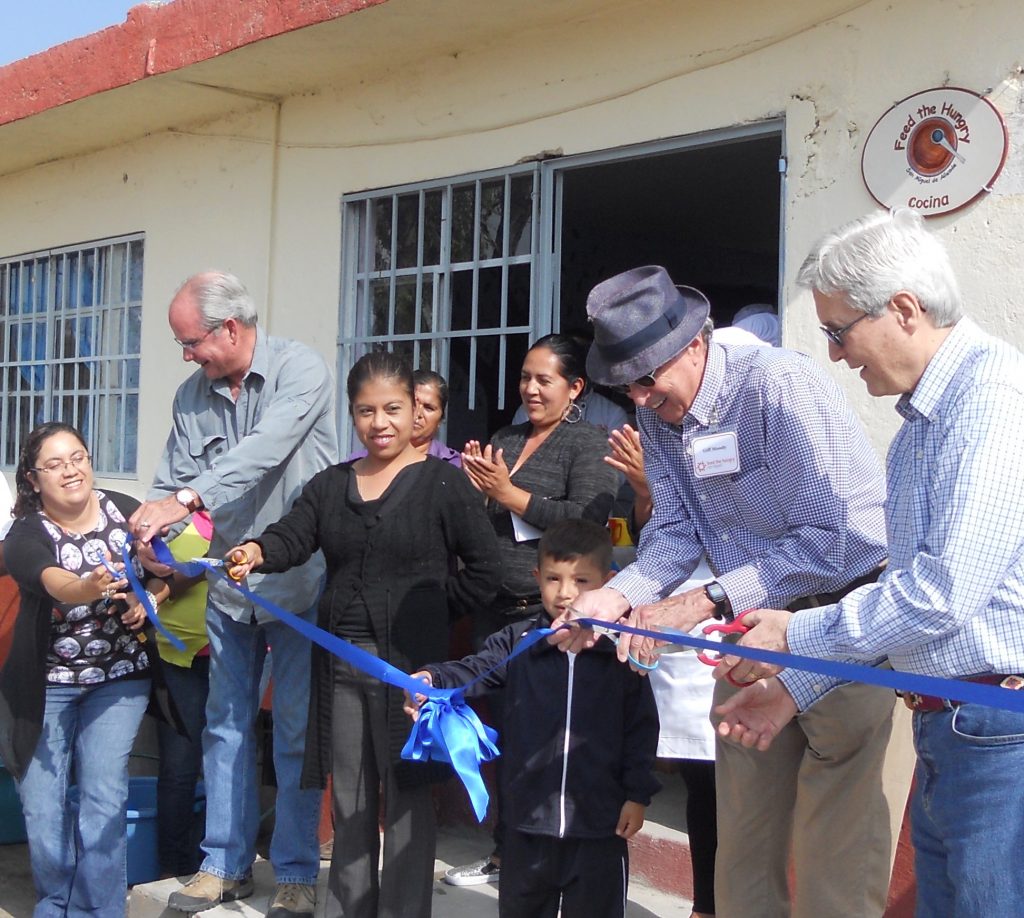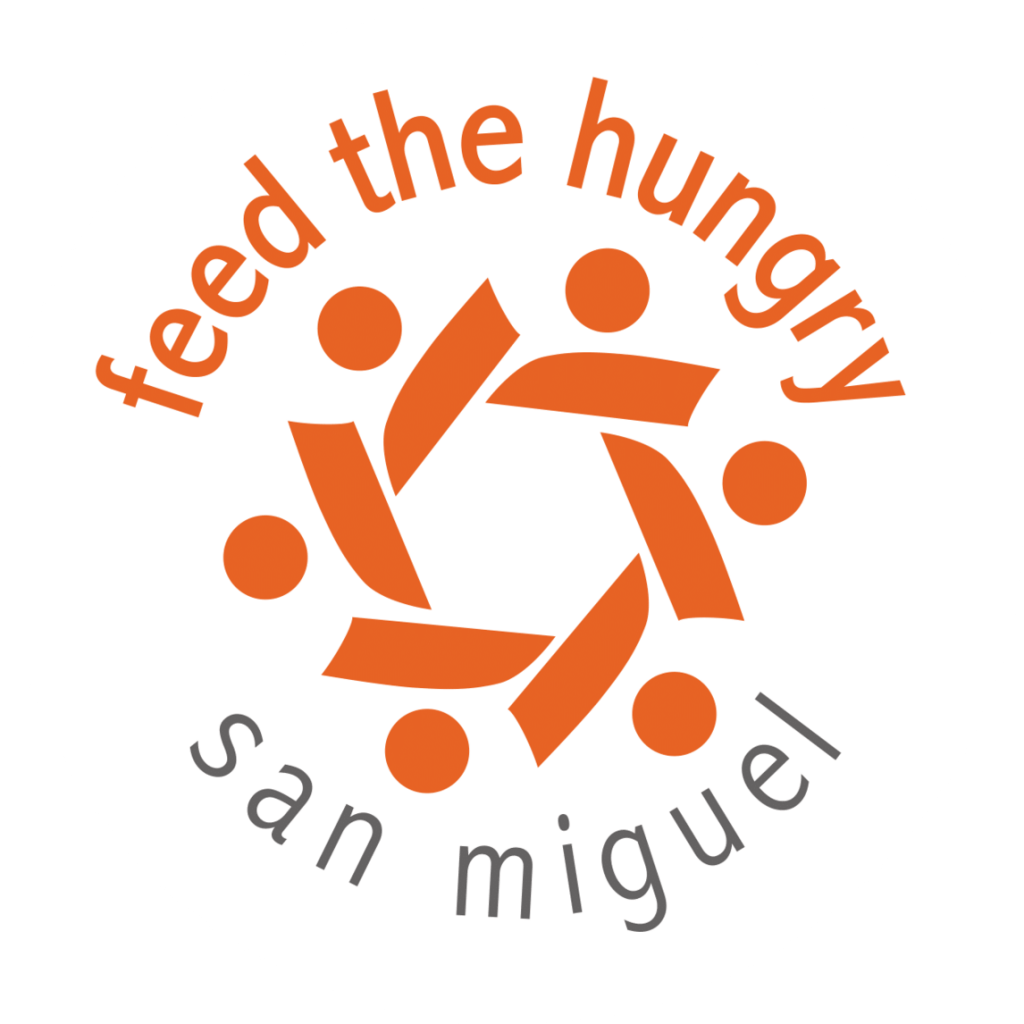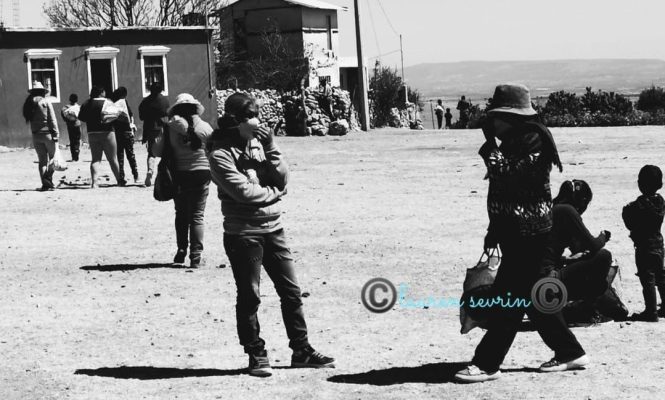
Established in 1984, Feed the Hungry San Miguel is an independent non-governmental and not-for-profit organization committed to improving the health and well-being of children and their families in the greater San Miguel de Allende municipality in central Mexico. We currently operate a combination of poverty alleviation programs that serve thousands of children and their families through school meals, nutrition education, support for pre-school age children, support for families at high risk of starvation, and cooperative programs with other NGOs and charities.
Donations are tax-deductible for U.S., Mexico and Canada (through our partnership with Amistad Canada).
OUR ORGANIZATIONAL STRUCTURE
- Feed the Hungry San Miguel, Inc. is a USA-registered charitable corporation that sets policy and raises funds to maintain the operating program. The Board of Trustees is all volunteer. A volunteer Advisory Council offers advice and provides assistance to the Board of Trustees.
- Feed the Hungry A.C. is a Mexican registered charitable company (Asociación Civil) that manages the operating program and allows for tax-deductible donations (donataria autorizada) for Mexican taxpayers. An all-volunteer Board of Trustees proposes operating budgets, manages finances, and directs operations. It also maintains contact and compliance with governing Mexican entities.
The Feed the Hungry A.C. Meals Program Director manages operations for meals programs and educational programs. The staff of 11 employees includes 5 kitchen supervisors, 1 head chef, 1 nutrition manager, 1 program administrator, 1 warehouse manager, 1 maintenance person, and 1 cleaning person. Additionally, 24 hired cooks are supported by 56 volunteer moms who operate our school kitchens.
Feed the Hungry A.C. Annual Reports
OUR FINANCES
We successfully operate a complicated enterprise and do so without a paid Executive Director. This is highly unusual for an operation of our size. We are successful due to the fact that we have an active, hands-on professional (and uncompensated) Board of Trustees.
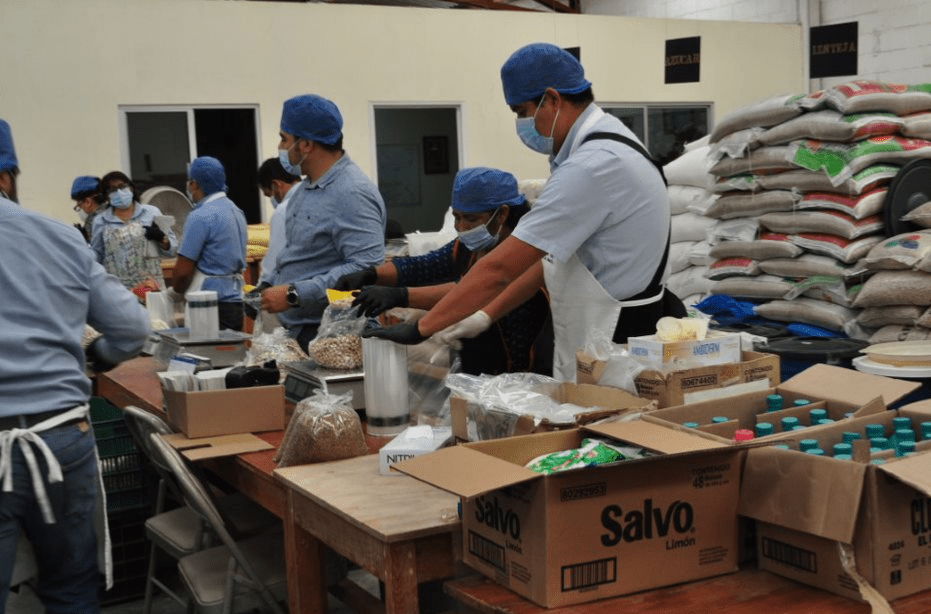
Operational efficiencies, volunteer power, and strong local relationships enable us to maintain the cost of a fresh, well- balanced school meal at just 86 cents (US). US$30 buys 36 meals to feed 2 children for a month. US$300 buys 360 meals to feed 2 children for an entire school year.
Our budget is almost entirely supported by gifts from donors. We plan to maintain at least two years’ worth of operating expenses in our endowment fund.
OUR HISTORY
Feed the Hungry San Miguel started as a small, informal charitable organization in 1984. See the timeline below for how we have grown and adapted to change over the past many years!
Leading up to the 30th anniversary of the organization in 2014, board member Dianne Walta Hart captured the recollections of several of the very special people who defined the mission, organized the processes, raised the funds, and kept the vision alive. Read their stories.
— Time Line
Members of St. Paul’s Episcopal Church begin an outreach program to feed the hungry indigent in San Miguel de Allende. Over the next 10 years, the program developed under the strong leadership and support of numerous volunteers.
A complete restructuring of the program takes place, including the design and implementation of a new operating model. This new model marks the beginning of Feed the Hungry San Miguel (FTHSM) as it is structured today; an independent non-profit organization with no religious, political, or government affiliations.
- Following close scrutiny of those communities whose needs could be satisfied through other sources against the greater need in rural areas, four kitchens were closed. Of the remaining four – Emiliano Zapata (177), La Nueva Senda (250), and Centro Infantil San Pablo (62) – remain open today. Leona Vicario (130) was closed in 2013.
- A house and property located in an urban neighborhood of San Miguel is donated to Feed the Hungry. This 252 square meter location becomes its operational facility.
Two new school kitchens – San Cristobal (81) and Cuadrilla (312) – are opened in rural villages.
Five rural school kitchens are opened in Alcocer (239), Galvanes (63), Rancho Viejo (220), San Miguel Viejo (73) and Palo Colorado (216). The property and construction adjacent to the operations facility is purchased and donated to Feed the Hungry. Renovations are completed in 2003.
Three school kitchens are opened in the rural villages of Las Cañas (113), Los Ricos de Abajo (84), and Jalpa (137). Feed the Hungry San Miguel formally establishes its 501(c)(3) status in the USA to qualify donations for tax deductibility.
- FTHSM’s largest to-date school kitchen is opened in rural La Campana (214). Upon special request, a school kitchen is opened in Plan Juarez (37), a severely poor indigenous community that is just outside Feed the Hungry’s self-imposed geographic boundaries.
- A special community literacy project is initiated with Los Ricos de Abajo.
- The single largest expansion of FTHSM’s school kitchen program takes place this year with the opening of five new locations – Estancia de San Antonio (153), Flores de Begoña (130), Peñon de los Baños (97), Clavellinas (290), and Pozo de Balderas (160) – all in rural communities. Feed the Hungry San Miguel qualifies for asociación civil status (FEED THE HUNGRY A.C.) enabling Mexican peso tax-deductible donations.
- Feed the Hungry San Miguel qualifies for asociación civil status (FEED THE HUNGRY A.C.) enabling Mexican peso tax-deductible donations.
Four rural school kitchens are added – Las Palmillas (84), Loma de Cocinas (109), Marroquin (33), and San Francisco (102).
- A pilot project is funded and undertaken as a cooperative venture with a local community development NGO to create family vegetable gardens; first in the community of Clavellinas and then in nine more rural communities where FTHSM has school kitchens.
- Feed the Hungry A.C. becomes a member of the Centro Mexicano para la Filantropía (Cemefi), a non-profit organization of business associations, foundations, companies, and individuals promoting “… the transparency and accountability of charitable organizations in Mexico.”
- An additional rural school kitchen – Fajardo de Bocas (88) – is opened.
- Late in the year, FTHSM undertakes a major initiative to link nutrition education to its school meals. The “Family Nutrition Education” (FNE) program will measure the nutritional health of each child participating in and benefiting from Feed the Hungry’s meals from its school kitchens. It provides counseling to mothers of the school children and conducts workshops for these women in the villages on the fundamentals of family nutrition.
- One large school kitchen is opened in rural Sosnabar (256) and the first school-kitchen gardens are planted in the Los Ricos de Abajo and Clavellinas communities.
- Feed the Hungry completes the purchase of a former commercial property on the periphery of SMA’s city-center. This operations facility provides for FTHSM’s warehousing and distribution needs, administrative offices, meeting and training rooms, and a demonstration school kitchen all in one location. The move to the new site was completed in the second quarter of the year.
- The Family Nutrition Education (FNE) program undertakes its first child health evaluation of 2,053 school children in 14 communities served by FTHSM’s meals program. Also, as integral part of the FNE program, 892 mothers from this same grouping attended nutrition education workshops.
- Family Nutrition Education has been introduced in all 27 communities and 1,057 mothers of school children have attended the workshops. Children are evaluated every six months. Measurements and indicators of malnutrition are documented and entered into FTHSM’s Nutrition Study.
- Feed the Hungry acquires accreditation for Canadian tax-deductibility through Amistad Canada.
- Following discussions with community leaders in two schools, Rancho Viejo (2003) and Leona Vicario (1990), it was determined that Feed the Hungry had successfully improved the health of the children and the communities could now be served by other means. While due to economic improvements in the communities, school-lunches are no longer required, the Family Nutrition Education Program continues to be available as needed.
- Feed the Hungry A.C. becomes the first non-profit in San Miguel de Allende to receive the Certification for Transparency and Philanthropic Accountability by Cemefi.
- The Family Garden Program expands to accommodate all communities that Feed the Hungry serves. Huertos Sustenables de San Miguel plants a school vegetable garden at every school where FTHSM has school-kitchens.
- Due to a new school meals program model in the community of Flores de Begona (2007) FTH relinquishes support of this kitchen to the municipality. The urban kitchen at La Nueva Senda in San Luis Rey (1998) is closed and three new rural kitchens – Pantoja (78), Montecito de Nieto (106), Tres Palmas (124) are opened under a pilot program. All the cooking and serving in these new kitchens will be handled by volunteers from the respective communities, under close supervision of FTH.
- September 2014 marks the 30th anniversary of Feed the Hungry San Miguel.
- At the Feed the Hungry center, installed a walk-in cooler for fresh produce and perishables. Implemented a second meal program in select full-day schools. Paid in full all remaining bond holders: Feed the Hungry became totally debt free.
- Launched the new model of community participation: instead of building kitchens; we locate needy communities where there’s space at the school, and work with the school to make it functional and hygienic, and then provide the appliances, plates, pots, and pans. We ask the mothers for their help to participate in getting their children balanced meals. We conduct seminars and have two full time nutritionists out in the field not only measuring the children’s progress, but also conducting classes with the mothers.
- Began new cooperative programs with Patronato Pro Niños and with the volunteer English teachers working in the community of Los Ricos de Abajo. Spun off the Garden Program into a separate, non-affiliated entity.
- Opened a new school kitchen in Alonso Yañez Primaria and began providing six local charities with food supplies that they prepare themselves.
- Opened a new school kitchen in Ejido Tirado at the Pedro Moreno kinder, serving 60 children, and a new kitchen at Don Diego primaria, serving 200 children. Hired a second nutritionist.
- Received a substantial bequest from the estate of two long term supporters, as part of the Planned Giving Program.
- Established a Feed the Hungry San Miguel Board of Advisors.
- Opened new school kitchens in Moral de Puerto de Nieto, Los González, Puerto de Sosa, Nuevo Pantoja, and La Medina; feeding more than 400 additional children every school day.
- Our first annual March Magic fundraising tour hosted 18 guests from 7 US states, providing a week of unique experiences in San Miguel
- Meals served in 2018: 922,493
- A new school kitchen opened in Nuevo Cimatario, a community on the municipal government’s list of rural populations in greatest need. In the Nuevo Pantoja community, a new kitchen was opened in the elementary school to serve 165 students. New dining facilities and a storage bodega were also constructed.
- We began providing breakfast at some kitchens so that the children are alert enough to concentrate on their lessons prior to lunchtime. And at five of our locations we began providing two lunches, due to extended school hours.
- Centro de Adolescentes de San Miguel de Allende, A.C. (C.A.S.A.) is now the seventh charity in the urban district that receives foodstuffs for daily meals from Feed the Hungry. CASA offers educational and daycare services for infants and children aged 45 days to 6 years old.
- The “March Magic” fundraising tour benefited the 260 students receiving meals at the school kitchen in Clavellinas. The “Autumn Magic” tour benefited La Campana, where 374 meals are served daily.
- Collaborating with Aqua Clara International (ACI) and the Universidad de Queretaro’s clean water technology center, ACI’s revolutionary filter system was installed in our Los Galvanes school kitchen, selected for the field test because of the high concentration of arsenic in the well water. Feed the Hungry worked with other NGOs to install cisterns for rainwater harvesting in some communities.
- Jonna Stratton, FTH Volunteer Coordinator, joined our Board of Trustees. She has been involved with FTH since 2011 and is also a Kitchen Angel for the Casa Hogar Mexiquito Boys’ Orphanage.
- Kathy West, FTH Advisory Board member, joined our Board of Trustees.
- Feed the Hungry San Miguel celebrated 35 years of providing hot, nutritious meals to needy children in San Miguel de Allende. In 2019, 975,695 meals were served to 4,700 children at 36 school kitchens.
- FTH nutritionists conducted 127 Cooking and Nutrition workshops for children and their mothers.
- The Early Childhood Nutrition Program was launched to provide sustenance for children aged from roughly one-year-old until they enter school. The program was fully implemented in Plan Juarez, La Campana, Alonso Yañez, and La Cuadrilla schools.
- A new school kitchen and dining room in the elementary school in the community of Nuevo Pantoja, where 170 nutritious lunches are served every school day, was officially inaugurated.
- A covered dining area was constructed for the children in the rural community of Alonso Yáñez and a new kitchen was opened in Palo Colorado.
- Work continued with other NGOs to ensure there is uncontaminated water for drinking and cooking in communities at risk. Caminos de Agua tested the water at our newest kitchens and consulted on solutions for sites that exceed the WHO limits for arsenic and fluoride, such as at Palo Colorado. There we worked together to make the existing water catchment system operational, and to install a line from the cistern to the adjacent new FTH kitchen.
- In 10 schools, children began receiving two meals each day. Two lunches are served at Estancia De San Antonio, Loma De Cocinas, Fajardo De Bocas, Centro Infantil Los Angeles, San Cristobal, Plan Juarez and La Campana. Breakfast and lunch are provided at Nuevo Pantoja kinder, Salitrillo, El Nuevo Cimatario kinder and primaria, Los Gonzalez primaria and Clavellinas.
- Volunteers who teach at Los Ricos de Abajo started tutoring the Feed the Hungry staff with English classes during summer break.
- Joan Nagelkirk joined our Board of Trustees, overseeing Strategic Planning initiatives within the organization.
- Alejandra (“Alex”) Rosas joined our Advisory Board. Maestra Rosas was a teacher, principal, and district supervisor within the state of Guanajuato for 34 years, including schools at La Campana and Sosnabar, where FTH operates school kitchens.
- A detailed historical timeline is available upon written request: bodo@feedthehungrysma.org
In early 2020, schools were closed by the COVID-19 pandemic, so our hot school meals program operations ceased.
Did that mean we shut down and went home? No. We undertook a mission that truly tested our organization’s ability to go above and beyond anything we could have predicted. People were desperate; we had to find another way to aid the communities we typically support. All while following new safety protocols.
The Feed the Hungry team quickly retooled all its activity to distribute food to the families of the children whom we normally serve. Every aspect of operations was affected: food procurement, packaging, delivering, identifying beneficiaries, and more. Without our usual volunteer packers and drivers, staff workload increased. Vacations were cancelled. Everyone did their share, and then some.
Here is a timeline of what most of 2020 was like at Feed the Hungry San Miguel:
March 11: The World Health Organization declares COVID-19 a pandemic.
March 17: Schools close in San Miguel de Allende; FTH suspends operations of school meals program.
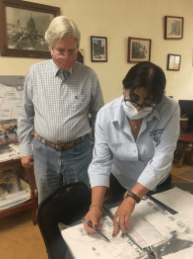
March 17-24: FTH operations team and board members meet to plan response to the emergency.
March 27: FTH is deemed an essential business and allowed to continue operations. Operations team enlists SMA city government’s Direccion de Desarrollo Economico to assist with delivery trucks, drivers, and volunteers to assemble bags of food.
March 30: Reconfigured warehouse; procured essential supplies and food. Began packing food bags with basics of disinfectants, hand sanitizers, and dry meal ingredients.
In just one day, operations staff weighed and packed 500 food bags of 14 kilos each, for immediate distribution.

March 31: Feed the Families program launched. 1,796 food bags were distributed in 19 rural communities and 9 neighborhood in San Miguel.
Over the next ten days, 5,500 food bags were distributed.
April 20: FTH unloads a 40-foot trailer of additional supplies for the growing need for food countywide.
May: FTH adds more communities and recipients to food bag distribution, including NGOs and individuals championing their neighborhoods. Now distributing food to 37 communities, 14 charities to feed 20,000.
June: Began packaging and distributing smaller food bags with eight basic products for smaller families and the elderly, who mostly live alone in the communities.
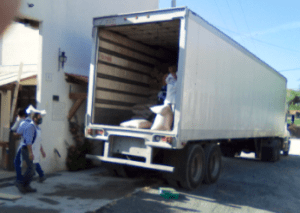
July: City government staff who had been supporting FTH in the warehouse had to return to their regular duties. Mothers who are cooks in our school kitchens were enlisted to take over the roles the staff from the city had been performing.
August: FTH nutritionists provide instruction and leaflets on nutrition, hygiene, proper use of masks, and hand washing techniques.
October: Six months into the program. 55,446 food bags (590 tons), equivalent to 6,526,630 meals distributed to the needy.
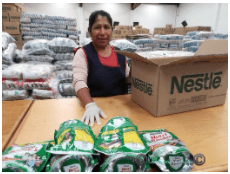
By year end: Food bags dispensed: 70,432 (687 tons) with ingredients for 7,767,390 meals. FTH nutritionists had delivered 150 workshops for 3,500 women on topics such as diabetes prevention and how to make creative use of the ingredients provided in the donated food bags.
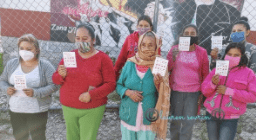
May 3, 2021, Feed the Hungry dedicates its Headquarters. Tony and Shirley Adlerbert are original founders of Feed the Hungry San Miguel and have been visionary leaders since its inception.
For decades, they contributed their time and their passion for helping others, to ensure the continued success of the organization and its mission. Tony served as president and executive director from 1994 to 2000 and has since been an active member of the Advisory Board. Shirley served as treasurer, led the volunteers program, and filled many other roles in the organization, including fundraising, purchasing, and recruiting, as well as delivering food to rural communities and serving meals at FTH school kitchens. “Feed the Hungry will always share a large part of our hearts and we are so grateful to have had the opportunity to give back,” said Tony.
After nearly 30 years living in San Miguel de Allende, Mr. and Mrs. Adlerbert are returning to the United States to be closer to family. In recognition of their leadership and dedication to the wellbeing of the children of San Miguel, Feed the Hungry has dedicated its headquarters to them. The farewell ceremony and unveiling of the building dedication sign took place on May 3. Together with the staff, cooks, board members, and directors, they joined in songs of joy and warm hugs as fond farewells were exchanged.
– Feed the Hungry earned 100/100 rating from Charity Navigator’s Encompass Rating System. This score designates Feed the Hungry San Miguel as an official “Give with Confidence” charity, indicating that our organization is using its donations effectively based on Charity Navigator’s criteria. Charity Navigator is America’s largest and most-utilized independent charity evaluator.
– Francis Bonilla and Jennifer Venkatraman join the Feed the Hungry Advisory Council.
– Feed the Hungry coordinated logistics and delivery of 1.3 million free medical-grade masks donated by Motus Integrated Technologies and CAM, a Stanley Black and Decker Company of Brea, CA. Our beneficiaries, as well as other charitable organizations, hospitals, and the local Mayor’s office in San Miguel de Allende, received masks to distribute across the municipality to those who need them. We also include a set of these masks in the food bags distributed to beneficiaries in the rural communities, and to the other NGOs associated with the food bag program.
– Feed the Hungry’s Early Childhood Nutrition program expanded to the community of La Palmilla.
– Mario Bravo joined our Advisory Council.
– Jennifer Venkatraman appointed to the position of Vice President of Feed the Hungry
- Feed the Hungry’s 34 school kitchens reopened (after closures due to the COVID pandemic), serving nearly 70,000 hot, nutritious meals every month to more than 4,000 children.
- New Student Hydration program piloted in three locations to provide purified water to children in elementary and kindergarten classrooms and for food preparation in school kitchens.
- New Extended Alimentation program launched to extend nutritional support for entire families who present cases of severe malnutrition.
- 373 nutrition workshops were conducted for mothers, to help them continue healthy eating practices at home.
- Mike Taylor named new president of Feed the Hungry San Miguel, Inc.
- New school kitchens opened in the communities of Don Francisco, Peña Blanca, and Cañada de Garcia.
- More than 800,000 school meals provided during the 2022-2023 school year.
- Student Hydration program expanded to 23 rural communities where water is contaminated or in short supply
More than 5,000 meals are served every school day in 37 school kitchens.
The Early Childhood Nutrition program is active in 15 communities, benefiting 194 children and their mothers.
The Extended Alimentation program is active in 7 communities, with 50 families enrolled.
Food is provided to local charities that serve orphans, children with disabilities, and the elderly.

